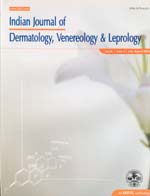
|
Indian Journal of Dermatology, Venereology and Leprology
Medknow Publications on behalf of The Indian Association of Dermatologists, Venereologists and Leprologists (IADVL)
ISSN: 0378-6323
EISSN: 0378-6323
Vol. 78, No. 1, 2012, pp. 64-67
|
 Bioline Code: dv12011
Bioline Code: dv12011
Full paper language: English
Document type: Research Article
Document available free of charge
|
|
|
Indian Journal of Dermatology, Venereology and Leprology, Vol. 78, No. 1, 2012, pp. 64-67
| en |
The effect of H 1 and H 2 receptor antagonists on melanogenesis
Anbar, Tag S.; Westerhof, Wiete; Badawy, Nafisa A.; Abdel-Rahman, Amal T.; Abd El-Raheem, Talal A.; Sayed, Saadea R.; Ali, Azza H. & Salem, Hossam
Abstract
Background: Histamine was found to stimulate melanogenesis in cultured human melanocytes specifically mediated by histamine H 2 receptors via protein kinase A activation. Based on this finding, the effect of topically applied H 2 antagonist on UVB-irradiated Guinea pigs' skin was examined and found to be suppressive on the post-irradiation melanogenesis.
Aims: In this study, we tried to explore the role of topically applied H 1 and H 2 receptor antagonists, in inhibition of UVB-induced melanization.
Methods: The effect of topically applied H 1 and H 2 receptor antagonists in inhibition of melanization was done clinically and histochemically using Fontana Masson and DOPA reactions compared with placebo.
Results: The post-irradiation pigmentation was found to be brownish/black instead of the original light brown color. This color change occurred below the shaved orange-red fur suggesting a switch of melanogenesis from pheomelanin to eumelanin. The induced pigmentation was suppressed by topically applied H 2 antagonist while both H 1 antagonist and vehicle had no effect. The microscopic examination showed that the keratinocytes in the H 2 antagonist-treated areas contained few melanosomes while the nearby dendrites are full of them.
Conclusion: H 2 antagonists' inhibition of UVB-induced pigmentation is not only due to suppression of melanization but also due to a specific action on melanosomes' transfer.
Keywords
H 1 blocker, H 2 blocker, histamine, melanocytes, melanosome transfer, melanogenesis
|
| |
© Copyright 2012 Indian Journal of Dermatology, Venereology, and Leprology.
Alternative site location: http://www.ijdvl.com
|
|
